After seeing games at every MLB ballpark on multiple occasions, I’ve made it my new goal sit in the best seats behind home plate at every ballpark at least once.
With all-inclusive food and beverage, various perks, and access to well-adorned club spaces in addition to your padded seat less than 60 feet from the batter, getting a “home plate club” ticket is a once-in-a-lifetime experience for baseball fans across the country.
However, despite their reputed exclusivity, home plate club seats aren’t hard to find on the secondary market at your typical ballpark. And if your timing’s right, they often sell at a loss, despite season tickets facing at new car prices. Single game good deals aren’t uncommon.
Which has made it mildly annoying that my home park’s version has historically been a stark exception.
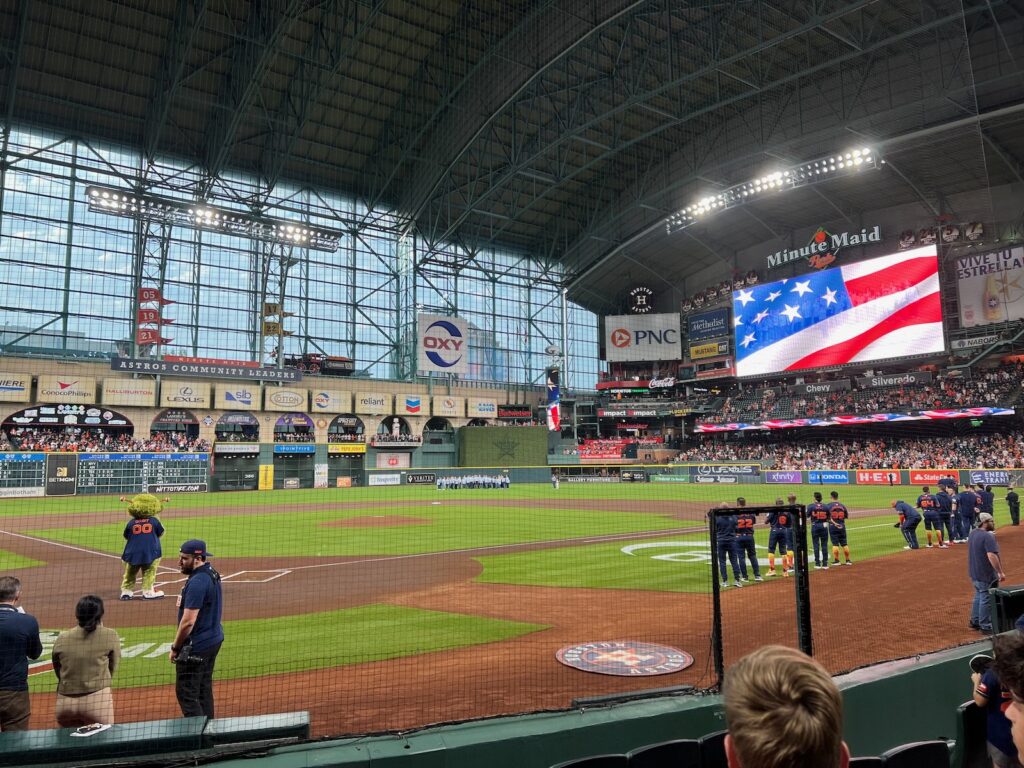
Minute Maid Park’s Diamond Club is one of the most exclusive and expensive seats in baseball. As one of the first ballparks (2000) with ultra-premium seating behind home plate, the Diamond Club is a truly rarified experience. For many Astros fans, it’s the mysterious white stag of tickets. Despite working steps from Minute Maid Park, I’ve had trouble getting in here, despite being able to buy equivalent seats with relative ease at road ballparks.
That is, until this year, where a single seat has been popping up on SeatGeek at deeply discounted prices. I had the pleasure of sitting here on April 1 and May 15, 2024. While I have sat here in the past as a guest, this is my first time buying in for the purpose of reviewing it.
As Astros fans know when they saw “April 1,” I’m burying the lede: that’s Ronel Blanco’s no-hitter, certainly the most improbable in franchise history. I’m nearing the 1000 mark of MLB games attended in my short life, and this was my first regular season no-hitter!
This will be one of my typical home plate club reviews, but I’ll also detail the no-hitter (with some unique on-field photos) below. I understand this piece splits different cross-sections of fans, so if you don’t care about the Diamond Club, scroll to the bottom section for the no-hitter.
I’ve seen games in home plate club “TV seats” in all but four MLB ballparks. Minute Maid Park’s Diamond Club has all of the expected amenities, but how does it compare to similar seats across baseball? Is it worth the price? Let’s find out.
Getting Diamond Club Tickets at Minute Maid Park
In the immortal words of George Carlin, it’s a big club, and you ain’t in it. Except the Diamond Club is a small club, and even if you have unlimited sums of money and status, you still ain’t in it.
The Diamond Club consists of the first nine rows in five sections behind home plate, plus the first three rows in two new sections behind home plate nearest to the dugouts on each side, adding up to just 343 seats. The actual club is located underground below the seats. The Astros do not sell single game tickets directly, so you’ll have to go to the secondary market. There is a long waitlist just to get the opportunity to purchase Diamond Club season tickets.
Longtime Astrodome season ticket holders, both corporations and obscenely wealthy individuals, got priority when Minute Maid Park opened, and many have held on to them for generations. Even during the rebuilding years of the early 2010s, the Astros never had to go too far down that waiting list to find willing buyers.
And just how much do those willing buyers pay these days? The Astros are tight-lipped on Diamond Club prices, but it came out that each seat starts at $49,000 per year in 2022. That’s approximately $605 per seat, per game! And we don’t know how much the front rows go for. And that’s pre-second World Series, before more inflation, so they certainly go for more now.
That’s the most expensive starting home plate club ticket price of any MLB team outside of New York and Los Angeles, with front row home plate club ticket prices something of black box.
In early years, if you weren’t one of these lucky few, the short answer on getting Diamond Club tickets was: you couldn’t. Even with the advent of online secondary ticket markets, tickets rarely pop up, and when they do, they actually hold their value: throughout the last 10 years, I’ve occasionally seen them go for $500-$1,000, sometimes less once in a blue moon.
Even in New York and Los Angeles, similar tickets can be bought for a discount on the secondary market.


I have some theories as to why Diamond Club tickets have traditionally been so difficult to obtain for a reasonable price compared to those in other markets.
For one, Minute Maid Park is the rare venue that seems to have underestimated the demand for premium tickets in its market. Houston, America’s fourth largest city, actually has the second most Fortune 500 companies in America, so the corporations take up a larger proportion of a relatively small amount of Diamond Club tickets. Similar versions in New York, L.A., Chicago, Dallas, and Atlanta have 1,350 to 700 seats. The corporations who disproportionately own the 343 Diamond Club seats are less likely to sell them on the secondary market.
Second, corporate or not, Houston’s elite are both rather cliquish and parochial, another reason why you don’t see these resold. Finally, rumor has it that the Astros used to heavily restrict a ticketholder’s ability to resell on the secondary market, so it just couldn’t be done. This was partially because George H.W. Bush, along with other Important People, sat here semi-regularly in the early days.
Anyway, I pounced on the opportunity to buy a single ticket for $300 (before fees and taxes) for April 1 in Section D, Row 5, Seat 6 on SeatGeek. That was about as cheap as I’ve seen them until that date. Then I saw the identical seat available for $149 for May 15, which is an insane value. Why this single seat is repeatedly being sold at the most discounted price I’ve seen in Diamond Club history is a mystery.
If you’re an Astros fan (or ballpark aficionado) who’s always wanted Minute Maid Park’s “TV seats,” such opportunities are scarce.
Accessing Minute Maid Park’s Diamond Club
Choice, VIP parking is nothing out of the ordinary for seats of this caliber, but Minute Maid Park’s setup is particularly seamless. The Diamond Lot, exclusive to Diamond Club ticketholders, sits steps away from the Premium Entrance used to access the Diamond Club. A nice perk, for sure.
Note that while Diamond Club season tickets come with the Diamond Lot parking pass, the parking pass may or may not come with your Diamond Club ticket if you buy the ticket off the secondary market. It’s in the discretion of the season ticket holder to sell the parking pass with the ticket.
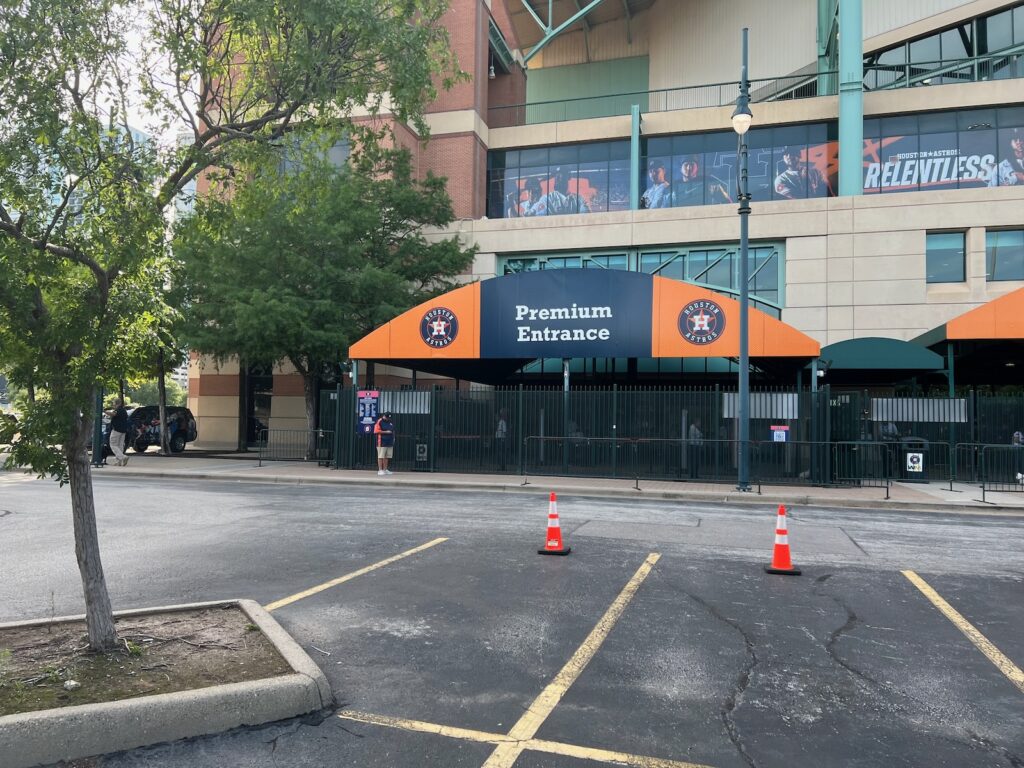
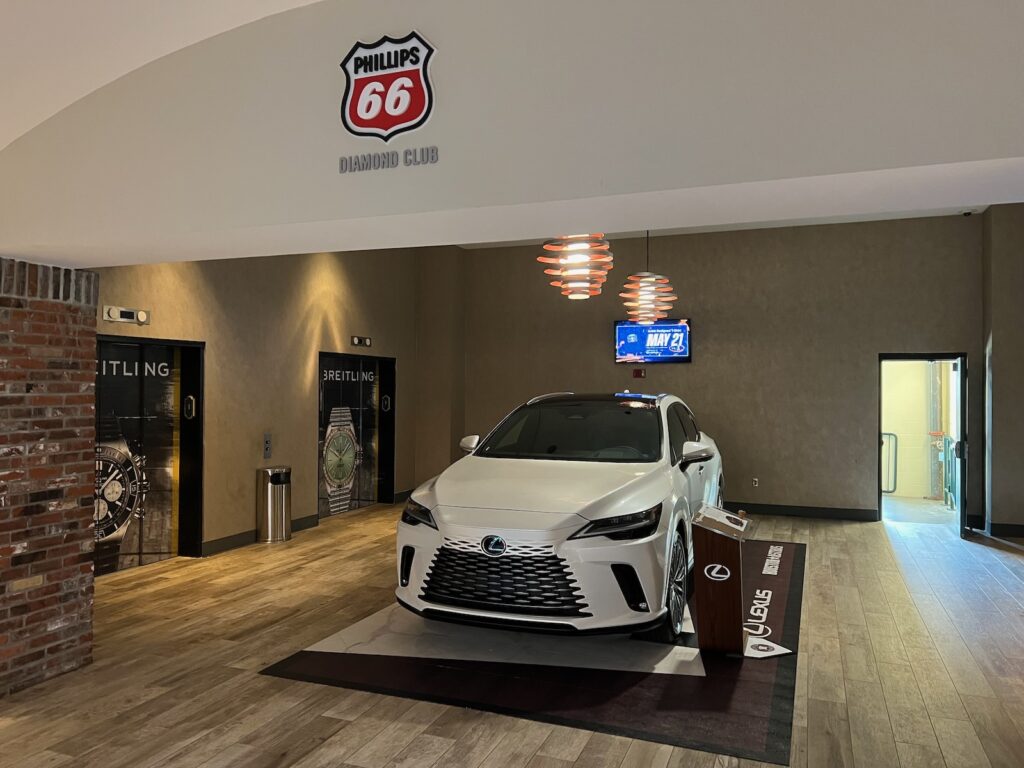
A private entrance is also typical for ultra-premium club seats at any sports venue, and Minute Maid Park uses the Premium Entrance located directly behind home plate next to the Clocktower.
The Premium Entrance is also accessible to those in the mezzanine club level, which sits around 5,000 fans, so the Premium Entrance isn’t particularly exclusive and may still have lines, for what it’s worth.
Once inside the Clocktower Lobby, you’ll make a left and encounter a new Lexus RX and elevator doors gilded with Breitling Watch advertisements. Just in case you need a reminder of the type of space you’re about to enter!
Take the elevators down, and you’ll encounter another plush lobby that sets the scene by highlighting the spaciousness of the Diamond Club. Some neat 2017 and 2022 World Series memorabilia is to the right, including the official scorecard from the no-hitter in Game 4 of the 2022 Series. The doors to the Diamond Club are at the end of this lobby to the left.


One odd thing I noticed compared to similar ballpark/stadium VIP experiences: they don’t scan your ticket twice once you reach the club.
This is done almost universally across the industry, as unscrupulous fans can use one ticket to get in the building, then present another fraudulent ticket (which would go undetected without a second scan) to get into an all-inclusive premium area. I know we have the Ballpark App now, but double scanning is still generally done. I guess they think no one would dare try and sneak in here! Anyway, not my concern, but that is unusual.
The Diamond Club opens at the same time as other Minute Maid Park gates, two hours before gametime.
The Diamond Club Design
Ultra-premium clubs in sporting venues have to strike a difficult balance. They should feel upscale, but not so upscale like a stuffy country club dining room or a casino VIP area. You still want to feel like you’re at a baseball game. Otherwise, you lose your sense of place.
They should be comfortable and casual, but not so casual as to not be properly differentiated from an ordinary sports bar or ballpark restaurant. You’re paying a huge premium for a memorable experience, after all. They should be fresh and modern, but not too polished as to come off as a brand-new generic hotel restaurant. You want some character and charm too.
Despite last being renovated in 2013, Minute Maid Park’s Diamond Club walks that line wonderfully well. It’s casually elegant, combining the excitement of a sports setting with the comfort and refinement of a high-end dining experience.

When the Diamond Club 1.0 opened in 2000, it already felt like an outdated space from the 1990s. It was dark like a bunker. It was cramped, sometimes unable to accommodate dining for all ticketholders. Its design was already passe, with brown wood tables and red table cloths.
The 2013 renovation made the new space totally unrecognizable from the old, adding 7,000 square feet by knocking down walls, elevating the ceilings, and consolidating unused areas like a smoking lounge and fax machine room, an ode to the 1990s idea that serious businessmen come to ballgames to conduct serious business (like I said, already outdated even in 2000).
It’s remarkable that the Diamond Club 2.0 is now over a decade old; it’s held up incredibly well.
Walking into the club, you’ll be greeted by a candy table, signaling this is a fun space with a touch of sophistication, not a staid dining room.

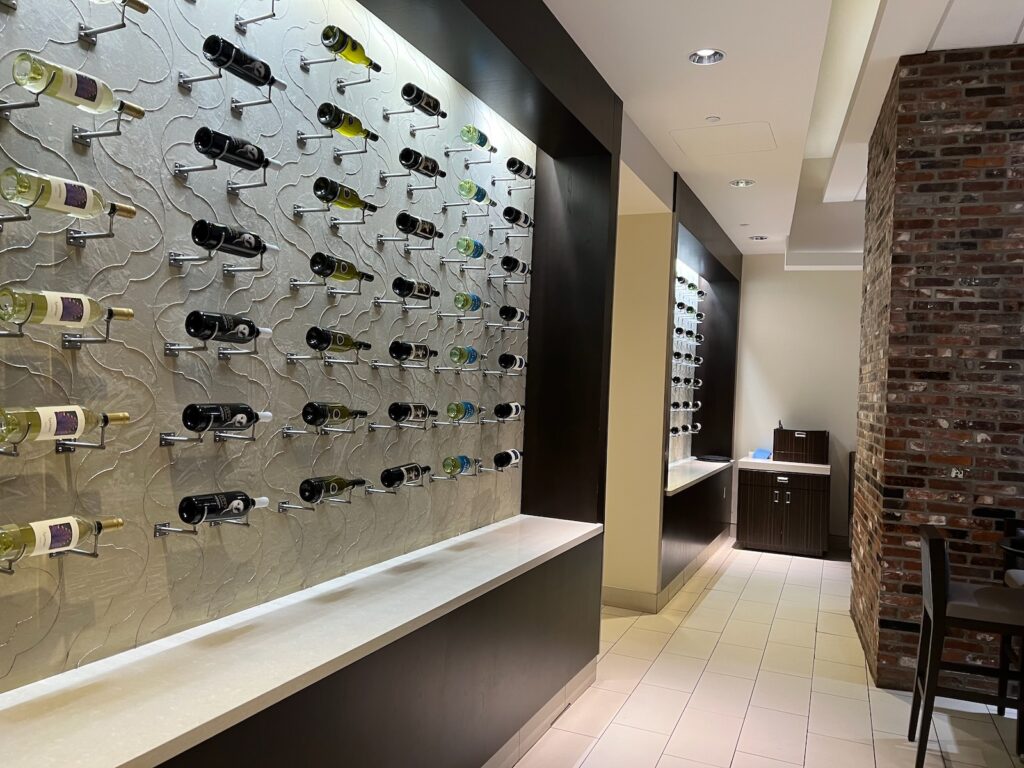

Dark wood tables and cushioned chairs dot the center of the space. The muted gray fabric feels stylish. A swank bar sits to the left of the club, while a wine display wall and the primary buffet area sit to the right. The Diamond Club features an open-hearth pizza oven at the back end of the club. There’s also a private dining room to the left at the front end of the club.
A few more observations on the space. Unlike other stadium bunker clubs, the Diamond Club feels bright and airy. Recessed ceiling lights liven up the entire space, while modern pendant lights hang over the bar area, creating a warm and welcoming vibe. Brick columns add a rustic and textured element to the otherwise sleek décor. It feels balanced, cozy, and grounded.
With over 17,000 square feet total, the club feels so spacious as well. It can hold 400-500 people despite a ticketed capacity of 343. Many comparable MLB spaces feel overcrowded and occasionally run into the problem of not being able to serve all ticketholders.
At the back end of the club to the right, there is a separate lounge area with couches and chairs. I love this feature. If you’re done eating and don’t want to go to your seat right away before game time, it’s nice to have a standalone social space to sit down and “hang out” other than at the bar. I don’t see this emulated in other premium spaces in MLB.


The Diamond Club’s restrooms are notable. Not only do they look like something fitting in a hotel lobby, there’s a restroom attendant handing out paper towels, along with frivolous amenities like hairspray and moisturizer. Haven’t seen that in a ballpark before! There’s a second, similarly well-appointed restroom in the left side tunnel leading to the seats.
But the Diamond Club’s best design feature, one also not found in any other home plate club in MLB, is the massive video display.
It’s not a TV broadcast, but a camera projection that gives those in the club the feeling of standing behind home plate and watching the game. Three projectors, connected to cameras set up above the field, beam live images of the game on the wall above the dining area.

This counterweights the primary downside of these underground home plate clubs. You by definition cannot view the field from inside the actual club. While the club is obviously intended to be enjoyed before and after the game, it’s nice to see the field while dining. And not just on a broadcast, but as if you were actually viewing the field raw in real time.
It’s the one element that makes this space feel like “baseball” versus a nice generic restaurant. To that point though, I do wish the Diamond Club had more Astros memorabilia/Astros references, or just explicit baseball references, which is my only real critique of the design. There are a few, but not enough. No boutique team store in the Diamond Club either, something you see in quite a few of these across baseball.
Overall, Minute Maid Park’s Diamond Club is just gorgeous. A sophisticated blend of casual comfort and upscale elegance, creating an inviting yet exclusive atmosphere. Warm and welcoming and lively and engaging, yet also with an appropriate amount of luxury and exclusivity.
It might not equal the extravagance of Seattle and San Diego’s newly renovated home plate clubs, or the unique speakeasy 1914 Club at Wrigley Field, but I’d put its design up against most other home plate club spaces in MLB.
The Diamond Club Food
If something even peripherally touches a minor aspect of the ballpark experience, I’ll analyze it. Hence, my esoteric discussion a premium stadium club’s décor! And hey, I’ve done something equally obscure that impacts all fans, like say, seating cantilevers, but I digress.
But at the end of the day, people are paying for (a) a seat behind home plate feet from the batter, and (b) gourmet all-inclusive grub. The fit and finish of the club is secondary.
The typical all-inclusive stadium club food isn’t particularly good. Catering is catering, and quality dining is difficult to do at scale. But I was pleasantly surprised, at times bordering on shocked, at the quality of the Diamond Club’s food. I don’t even like buffets, much less stadium buffets, but everything was delicious.
Yankee Stadium’s Legends Suite is a different beast – the best premium food in sports, period – but I’d also put the quality of Minute Maid Park’s Diamond Club’s food against most others. The variety is average.
Apparently, the Astros revamped their menu in 2022 under the guidance of new head chef Kris Kumthub, and it shows.
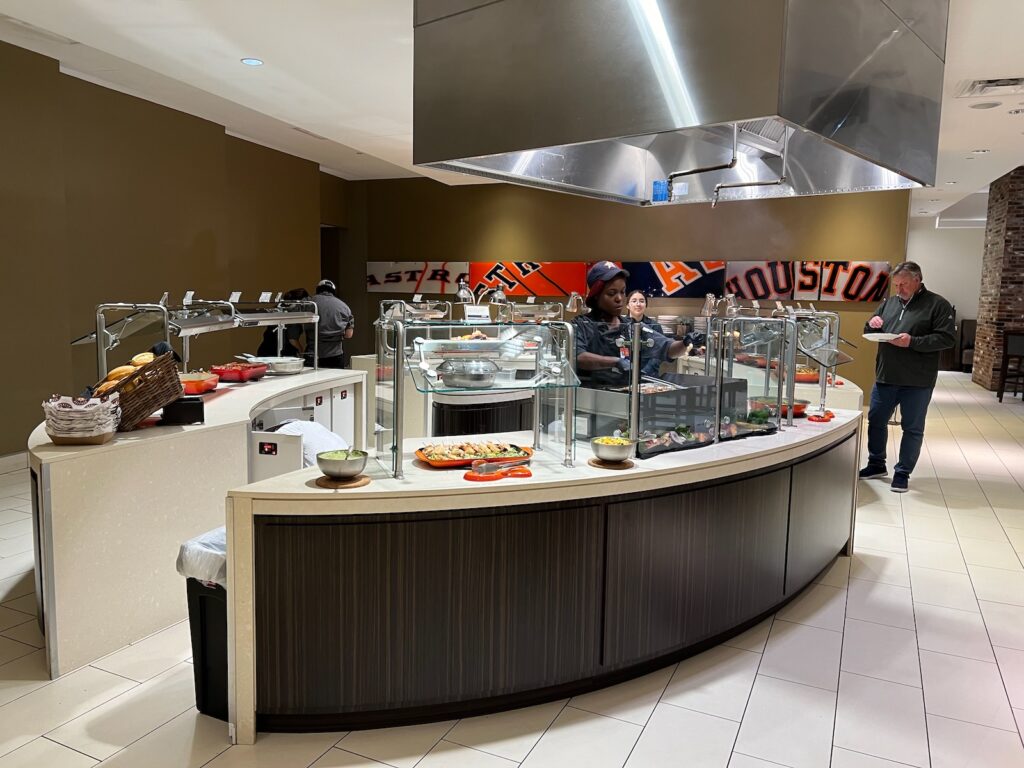
I talked about striking the right balance with the design, but the Astros do the same with the premium food. I don’t want vegetable medley, barley salad, wild rice, and dry chicken at a baseball game, to single out the White Sox, where basically nothing was edible (which is ironic, because the concession stand food there is great). I also want more than hot dogs and burgers, or even high-end small bites, at this ticket price.
I’d describe the Diamond Club food as a typical high-end buffet food mixed with elevated comfort options.
Most of the main buffet items in the right-hand corner rotate each game, along with the rotating action station adjacent to the buffet.


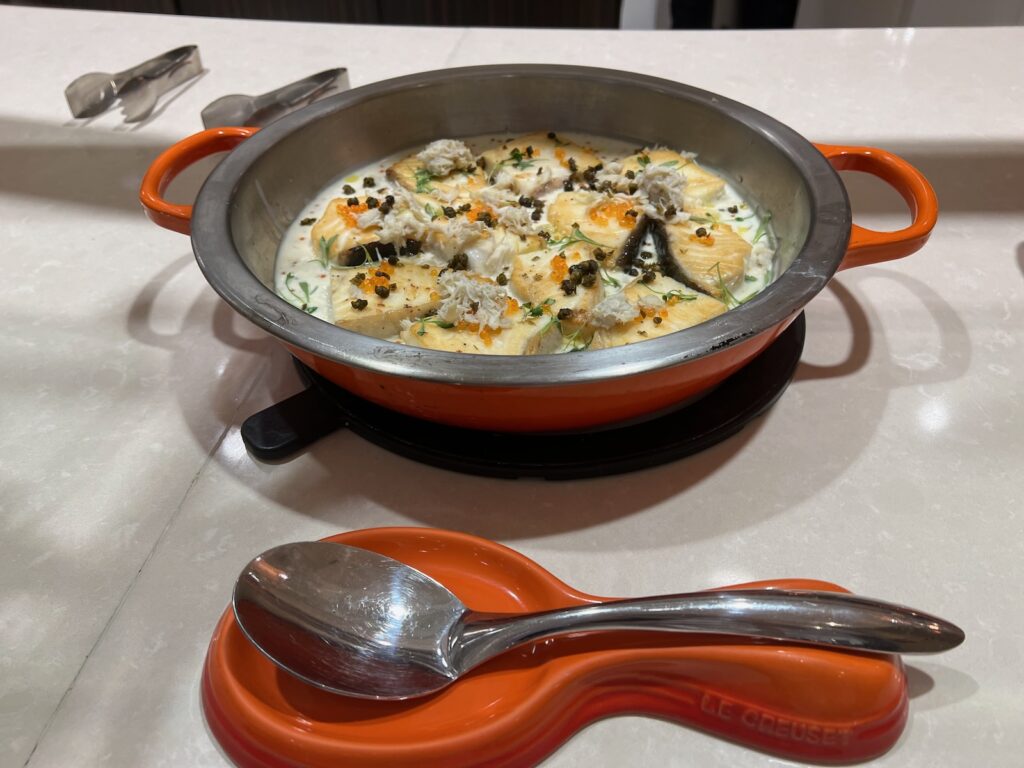
On April 1, meats included (1) beef coulotte steak, (2) skillet pork chops, (3) pan-seared halibut topped with blue crab, (4) bay scallops with gnocchi, and (5) grilled shrimp skewers. Carb and veggie options included poached asparagus, mashed potatoes, pesto rice, and roasted cauliflower. The “action station” served freshly prepared Maine-style lobster rolls.
On May 15, meats included (1) Dijon roasted teres major steak, (2) southern smother pork chops, (3) flounder with crabmeat, and (4) pesto grilled chicken. Carb and veggie options included haricots vents almondine, mashed potatoes, ratatouille rice, vegetable baked parmesan, and something that should be required at every buffet, lobster mac & cheese. The “action station” served shrimp roasted cream corn risotto with peppercorn bacon.
Tastes in food are subject to the individual’s moods and whims, so who knows, but I could not believe the quality of this food.


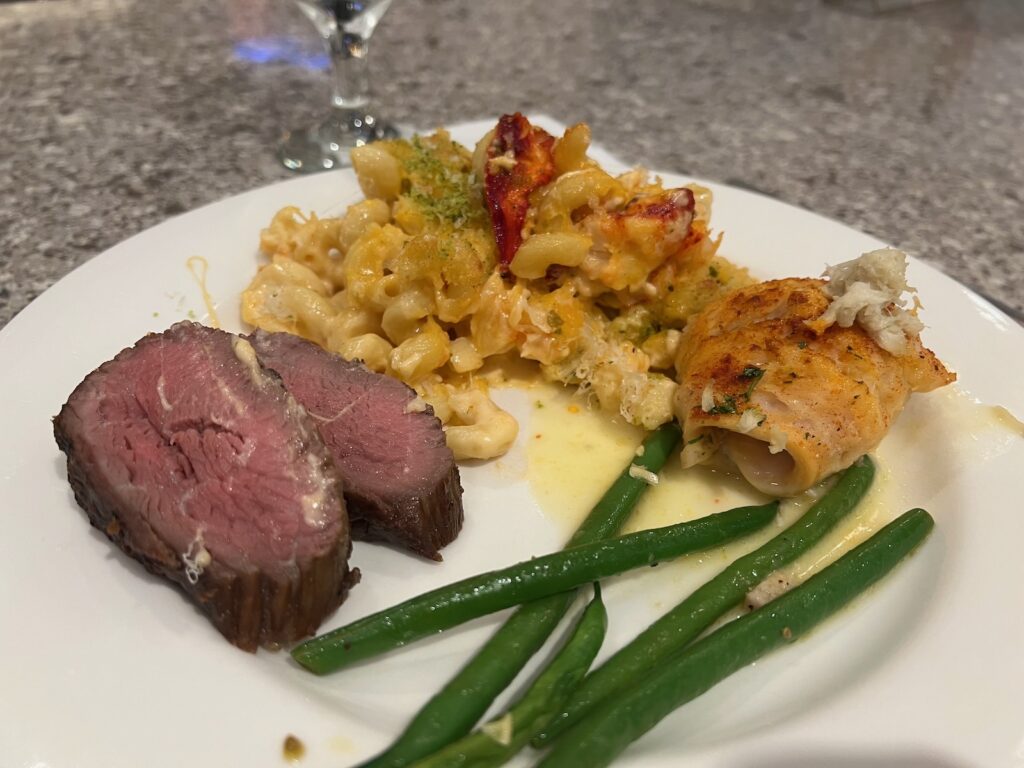
I can get into full “ballpark mood” and love standard ballpark food, but when it comes to nice grub like this, I’m quite picky. Don’t screw it up. Instead of the usual prime rib with 50% fat served at a typical stadium buffet, the Diamond Club serves steak, properly cooked. The halibut, scallops with gnocchi, lobster rolls, and pork chops were also standouts.
But while everything above was fabulous, but I’ll single out the shrimp risotto, which was legitimately high-end restaurant quality.
Burgers, hot dogs, and the Diamond Club’s famous fried chicken (apparently one guy makes the fried chicken, and if he’s out, everyone notices the chicken’s different) are the only mainstays at the buffet. Outside of the main buffet and the action station, the Diamond Club serves a variety of freshly made breads at various stations, a nacho bar with real queso and fajita steak/chicken, a salad bar, and a fresh fruit tray next to fruit-infused water stations, and charcuterie.
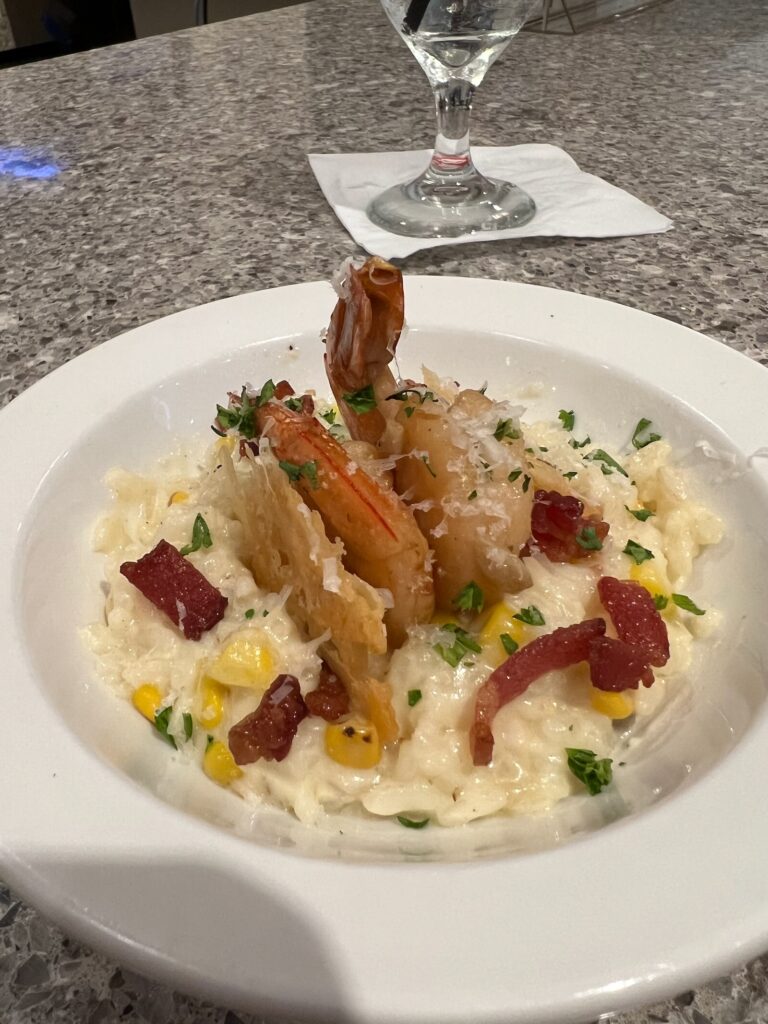


The Diamond Club’s pizza game is about as good as it gets, serving six varieties of pizza, including Hawaiian and Bluefin Tuna, at the open-hearth oven in the back of the club. You’ll also find flatbreads and composed salads here. All of the buffets are open until around the 7th inning, depending on management’s discretion.
The desert selection is average, but delicious nonetheless. The ice cream bar has four varieties, plus three kinds of gelato. Coke and root beer floats are favorites. Other deserts include cupcakes, cookies, strawberry cheesecake cups, mini cannoli, key lime pie, and cake balls. “Candy Walls” have become a staple in these premium clubs across sports, and the Diamond Club’s aforementioned candy table is a crowd-pleaser.
Overall, the Diamond Club’s all-inclusive food greatly exceeded my expectations. This can obviously vary not just by year, but by game, but based on my experiences, I’d put the grub around the top-5 of MLB ballpark premium food. The variety isn’t too dissimilar between ballparks here, but the quality I experienced was genuinely notable for a stadium buffet.
The Diamond Club Drinks
Let’s just say drinks aren’t the Diamond Club’s strong suit, and it has nothing to do with the staff.
Out of MLB’s 22 all-inclusive home plate clubs (5 have non-all-inclusive clubs, 3 have no home plate premium seating), 14 include beer and wine in the ticket price, with 12 including all alcohol in the ticket price. Minute Maid Park’s Diamond Club does not include any alcohol in the ticket price.
Bottled water, soft drinks, and basic coffee (although not anything special, and you have to ask) are included. I understand the Astros’ rationale here, but having to pay for alcohol with a $600+ ticket is a big strike against the Diamond Club compared to other MLB premium spaces.

You can see the menu here, but the selection of alcoholic drinks isn’t notable. The Diamond Club’s excellent bartender, Bilal, will make you anything you want, but there’s no specialty cocktail menu, also fairly unusual.
Maven, a new venture by the Houston Astros’ starting barista Lance McCullers, serves expresso martinis and carajillos for $23.
On the plus side, the Diamond Club’s bar is open until 45 minutes after the game, depending on activity and management’s discretion. A handful of premium clubs do this, but that’s certainly a nice perk when you’re waiting for the traffic to die down or want to celebrate a big W.
Diamond Club Seats and the Game
Two tunnels flank the back end of the Diamond Club leading directly to the seats. Within the tunnels, there are grab and go stands with bottled water, popcorn, peanuts, and cotton candy, along with a friendly lady handing out paper scorecards free of charge. The left side tunnel is adjacent to the team clubhouse and press conference room.
A small “moat” separates the Diamond Club seats from the rest of the seating bowl, and unlike similar spaces in MLB, there’s no aisle to access the club seats from the rest of the seating bowl. It’s only accessible from inside the club.
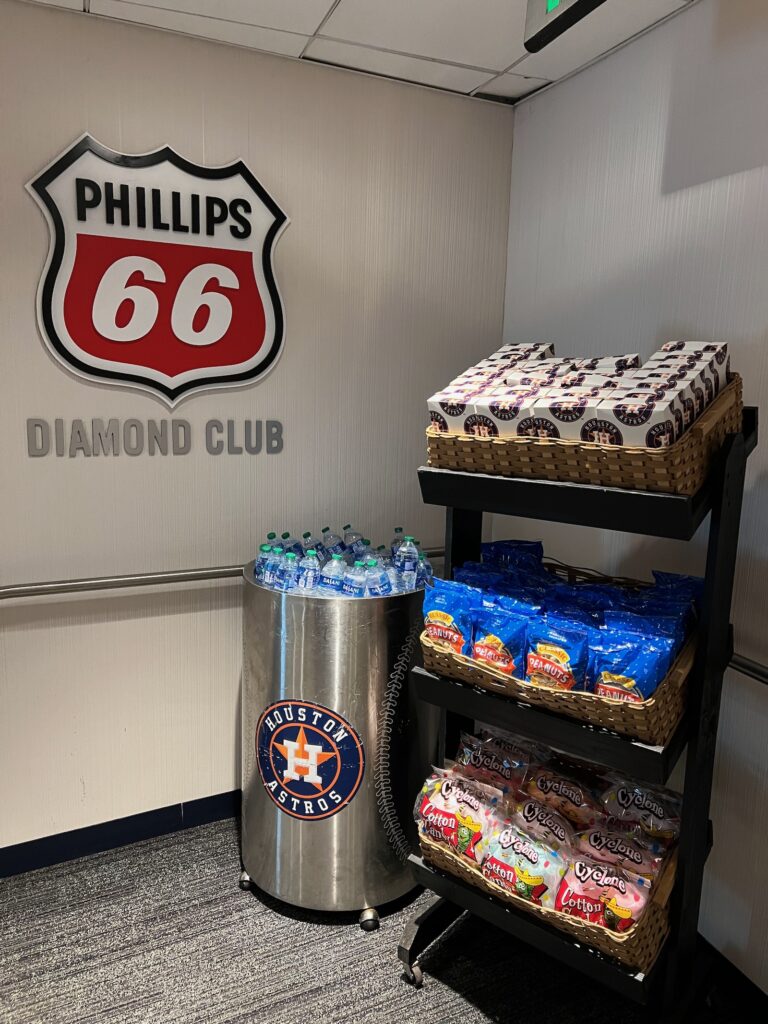
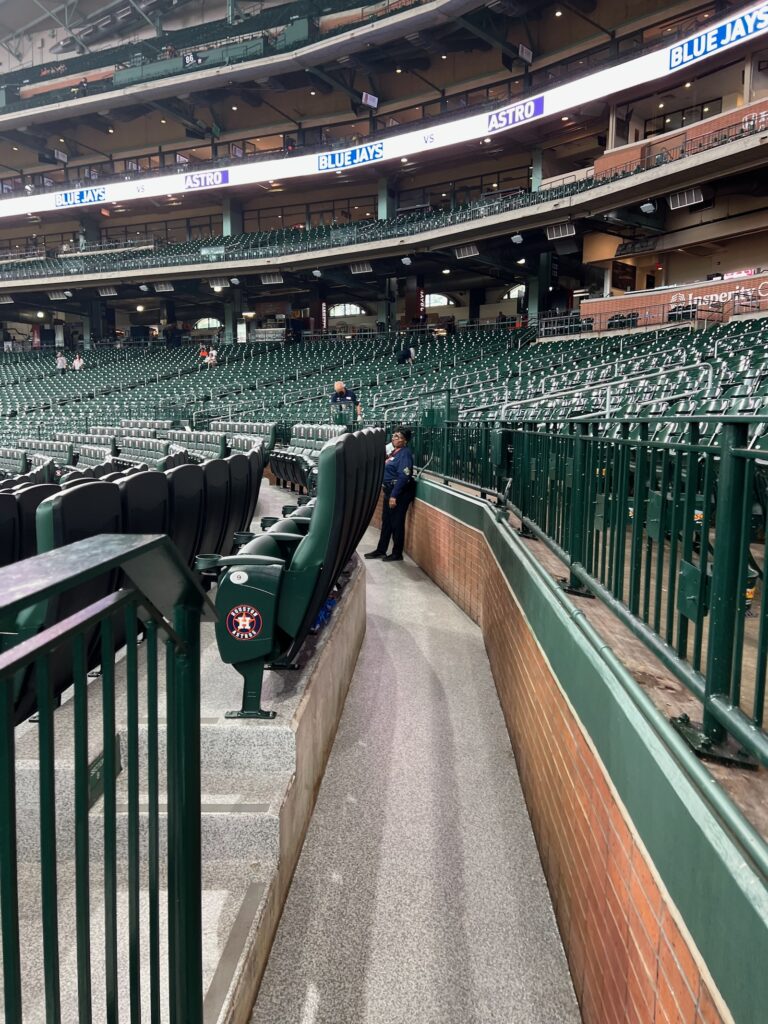
Fully padded, wide, theatre-style seats are common in these parts in other ballparks, but the Diamond Club seats are as plush as they come. Brand new for 2024, the high back, extra cushioned seats have ample legroom and cupholders in the armrests.
In-seat wait service is perhaps the most appearing part of stadium club seats, with the idea that you shouldn’t have to miss a pitch to get food and beverages. That’s not quite true in the Astros’ Diamond Club.
While the in-seat service staff is diligent (shout out to Rick!) – they come up and down the aisle every inning or sooner, so this isn’t on them – there’s no in-seat service menu where you can order food from your seat. Other MLB home plate clubs have menus where you can order plates, snacks, and desserts from your seat.
In the Diamond Club, you can only order drinks at your seat (no menu, but whatever you want, for the same cost as inside), although the servers will occasionally come by to hand out complimentary peanuts, cracker jacks, and bottled water, which you can also grab in the tunnels.
I took my seat about 15 minutes before game time, just to the right behind home plate 6 rows from the field. Perfect timing and positioning to get a wave from Orbit and his crew! During the game, Orbit will swing by and walk down the aisle for personal photo opts with each fan – a really cool perk I’ve seen in a few other home plate clubs as well.
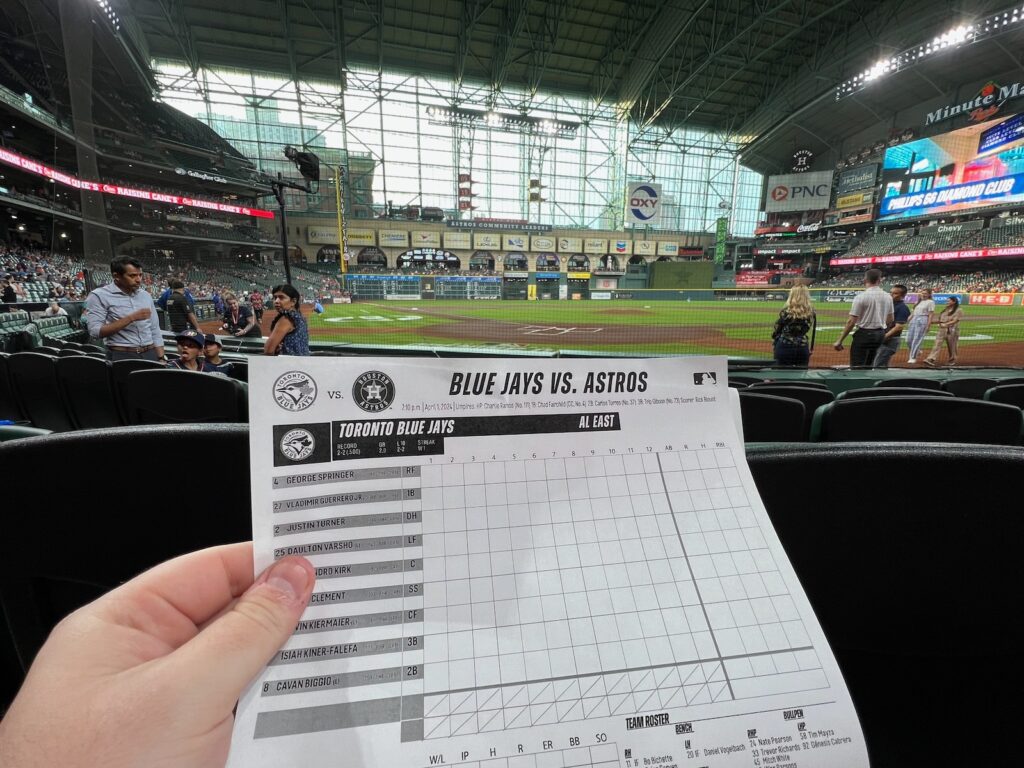


The Diamond Club is known for its people watching, with some of Houston’s most notable residents sitting here, including Tilman Fertitta and Lynn Wyatt. Astros’ owner Jim Crane also frequents these seats, often even preferring it to his private luxury suite. Craig Biggio was sitting a few sections to the right of me – he makes a reappearance below.
Coming off a sweep by the Yankees to start the season 0-4, the Astros came back big. Ronel Blanco, who just got told he made the rotation on the day of his daughter’s birth less than a week earlier, had his off-speed stuff going early. The Jays apparently didn’t have his changeup well scouted, and it was noticeable up close. He actually opened the game with a walk, but it was smooth sailing from there.
The Astros bats finally came alive with a barrage of home runs. Kyle Tucker hit a two-run shot in the first, followed by a solo round tripper from Yainer Diaz. That was followed by Jeremy Pena’s solo blast in the second inning, along with a second two-run homer by Tucker and second solo shot by Diaz in the seventh inning.
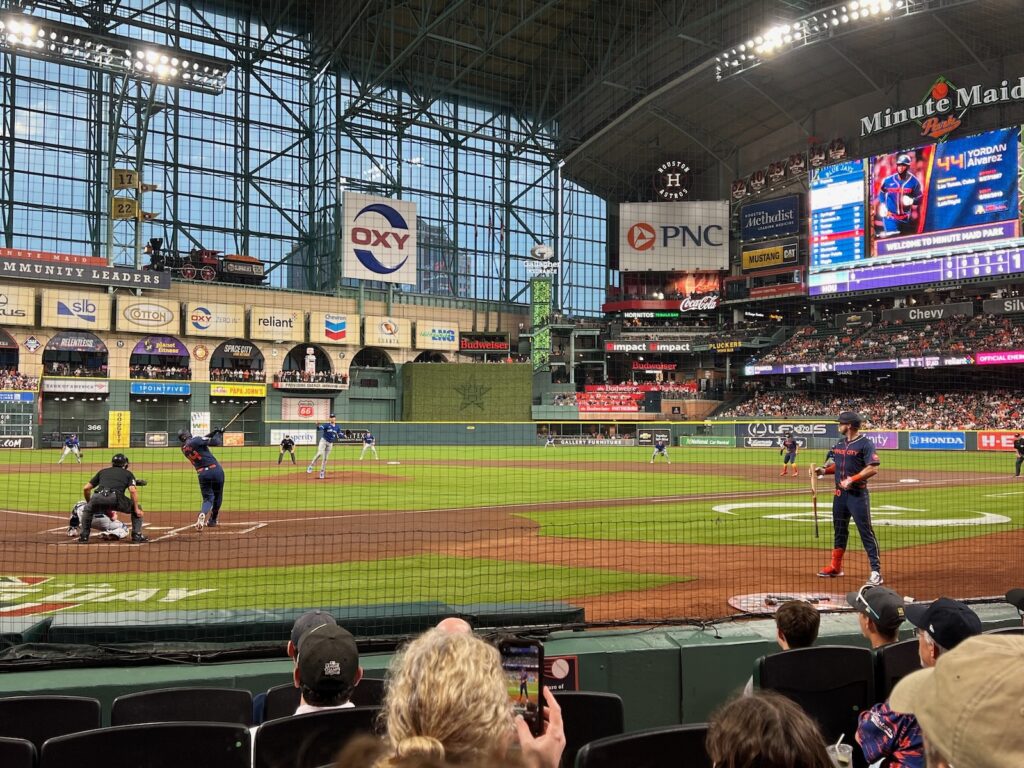
By the top of the eighth inning, it was 10-0 Astros.
At that point, there was a vibe in the building that Something Big is happening. Some of the Diamond Club’s corporate crowd – corporate even by corporate seat standards – who were mingling inside of the club with no interest in the game began to scamper to their seats.
After walking George Springer to start the game, Ronel Blanco retired 24 straight Blue Jays entering the top of the ninth. His journey to the big leagues included working part-time at a car wash in the D.R. to help his mother after getting signed by the Astros at age 22 – exceptionally late by foreign player standards – and he was three outs away from a no-hitter in his 8th career start at age 30.
Following a two-out ninth inning walk to Springer, Blanco induced a weak ground ball to second for one of the more improbable no-hitters in recent MLB history. Joe Espada also became the first manager in MLB history to have his first career managerial win come as a no-hitter.
Blanco induced lots of soft contact and swings and misses on his changeup – including all seven of his strikeouts. All told he threw 36 changeups, 34 sliders, 31 fastballs and four curveballs. He forced 59 swings in the game, including 20 misses – half of which came on his changeup.
As you can see by the video, right after the final out I scurried down to the first row. A bit later, that’s where I saw Craig Biggio escorting Ronel Blanco’s mother to the field!
Biggio’s title with the Astros is “Special Advisor, Baseball Operations & Community Outreach Executive,” but you’ll see him doing nice things like this all of the time, which may or may not be in the scope of his position. After the game, he spent time chatting it up with fans.

So, there it is – my first no-hitter, at my home park, in the park’s best seats that I’ve been trying to get for a decade. I’ve had some near misses recently – Marcus Stroman’s Memorial Day one-hitter at Wrigley Field and Domingo Germán’s perfect game in Oakland (I almost attended) last year, for example – which makes it all the more special.
Given the circumstances, I’d stack up this game with any I have seen, including All-Star Games, post-season walkoffs, World Baseball Classic finals, and World Series’ classics.
Is Minute Maid Park’s Diamond Club “worth it?”
Hell yeah, when you see a once-in-a-lifetime game and get the deal I did! But real talk, is it ordinarily worth it at typical prices for average games?
I gave a more detailed answer to this in my Yankee Stadium Legends Suite review, but essentially, “worth it” is a highly subjective question. On the one hand, unlike some other home plate club experiences at lower prices with alcohol included, you’re not getting much objective value here. You could save hundreds of dollars by eating at the best restaurant in Houston before the game and then just buying seats in the first row behind the Diamond Club. No matter how many shrimp risotto dishes you eat, it’s difficult to justify $600+.
But ultimately, I don’t think this is about value on an everyday basis. For season ticket holders, it’s about being in an elite group. For the rest of us, I think it’s something you should try to experience at least once!
Overall, how does Minute Maid Park’s Diamond Club compare to other MLB ballpark home plate clubs or premium seating experiences?
Pretty well. On the plus side, the bright and airy Diamond Club space still looks immaculate despite being over 10 years old, with a timeless casual elegance and unique projector screen that makes it feel like you’re at a baseball game, not a generic restaurant. The all-inclusive food is delicious, and the service is thoughtful.
The food, service, club space, and seats (not much differentiation between ballparks here, obviously) are all elite, even in the highly competitive space of premium stadium hospitality.
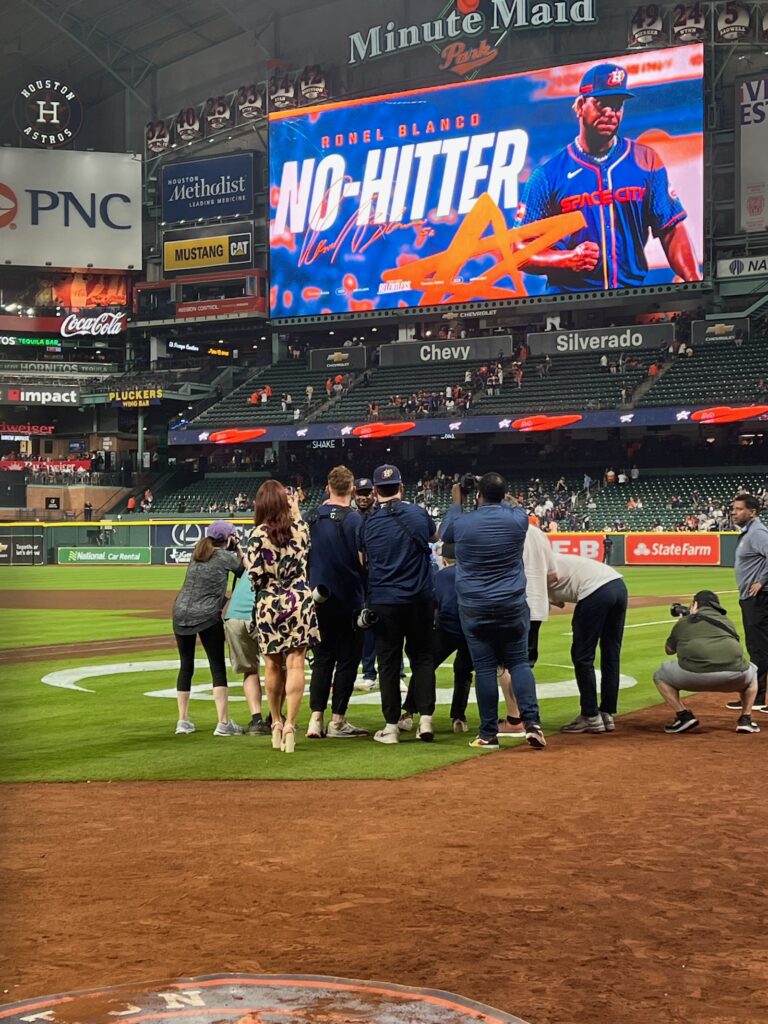
On the downside, in this comparative exercise, the Diamond Club is at a disadvantage compared to the dozen plus MLB home plate clubs that include alcohol in the ticket price. For $600+, that’s a fairly significant misgiving. In addition, there’s no option to order food at your seat, another differentiator from most comparable seats in baseball.
Ultimately, Minute Maid Park’s Diamond Club is at least on the periphery of the top-10 for MLB stadium home plate seats, which is no slight. It’s a bucket list experience for Astros fans and stadium enthusiasts alike.